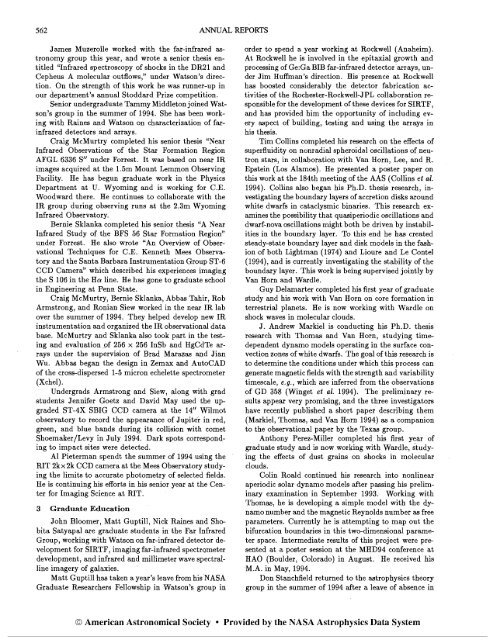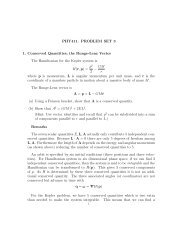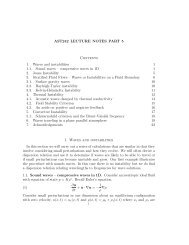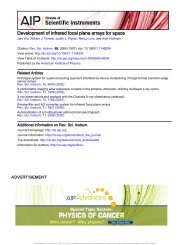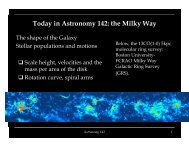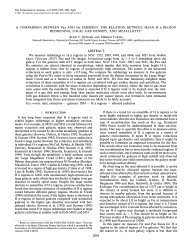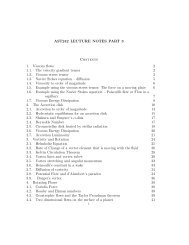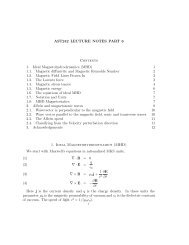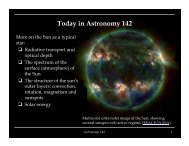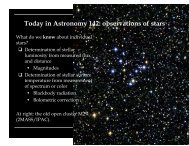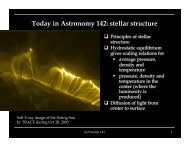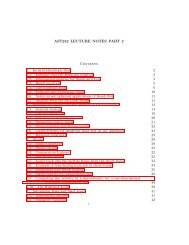University of Rochester C. E. K. Mees Observatory - Astro Pas ...
University of Rochester C. E. K. Mees Observatory - Astro Pas ...
University of Rochester C. E. K. Mees Observatory - Astro Pas ...
You also want an ePaper? Increase the reach of your titles
YUMPU automatically turns print PDFs into web optimized ePapers that Google loves.
562 ANNUAL REPORTSJames Muzerolle worked with the far-infrared astronomygroup this year, and wrote a senior thesis entitled"Infrared spectroscopy <strong>of</strong> shocks in the DR21 andCepheus A molecular outflows," under Watson's direction.On the strength <strong>of</strong> this work he was runner-up inour department's annual Stoddard Prize competition.Senior undergraduate Tammy Middleton joined Watson'sgroup in the summer <strong>of</strong> 1994. She has been workingwith Raines and Watson on characterization <strong>of</strong> farinfrareddetectors and arrays.Craig McMurtry completed his senior thesis "NearInfrared Observations <strong>of</strong> the Star Formation RegionAFGL 6336 S" under Forrest. It was based on near IRimages acquired at the 1.5m Mount Lemmon ObservingFacility. He has begun graduate work in the PhysicsDepartment at U. Wyoming and is working for C.E.Woodward there. He continues to collaborate with theIR group during observing runs at the 2.3m WyomingInfrared <strong>Observatory</strong>.Bernie Sklanka completed his senior thesis "A NearInfrared Study <strong>of</strong> the BFS 56 Star Formation Region"under Forrest. He also wrote "An Overview <strong>of</strong> ObservationalTechniques for C.E. Kenneth <strong>Mees</strong> <strong>Observatory</strong>and the Santa Barbara Instrumentation Group ST-6CCD Camera" which described his experiences imagingthe S 106 in the Ha line. He has gone to graduate schoolin Engineering at Penn State.Craig McMurtry, Bernie Sklanka, Abbas Tahir, RobArmstrong, and Ronian Siew worked in the near IR labover the summer <strong>of</strong> 1994. They helped develop new IRinstrumentation and organized the IR observational database. McMurtry and Sklanka also took part in the testingand evaluationpf 256 x 256 InSb and HgCdTe arraysunder the supervision <strong>of</strong> Brad Marazas and JianWu. Abbas began the design in Zemax and AutoCAD<strong>of</strong> the cross-dispersed 1-5 micron echelette spectrometer(Xchel) .Undergrads Armstrong and Siew, along with gradstudents Jennifer Goetz and David May used the upgradedST-4X SBIG CCD camera at the 14" Wilmotobservatory to record the appearance <strong>of</strong> Jupiter in red,green, and blue bands during its collision with cometShoemaker/Levy in July 1994. Dark spots correspondingto impact sites were detected.A1 Pieterman spendt the summer <strong>of</strong> 1994 using theRIT 2kx2k CCD camera at the <strong>Mees</strong> <strong>Observatory</strong> studyingthe limits to accurate photometry <strong>of</strong> selected fields.He is continuing his efforts in his senior year at the Centerfor Imaging Science at RIT.3 Graduate EducationJohn Bloomer, Matt Guptill, Nick Raines and ShobitaSatyapal are graduate students in the Far InfraredGroup, working with Watson on far-infrared detector developmentfor SIRTF, imaging far-infrared spectrometerdevelopment, and infrared and millimeter wave spectrallineimagery <strong>of</strong> galaxies.Matt Guptill has taken a year's leave from his NASAGraduate Researchers Fellowship in Watson's group inorder to spend a year working at Rockwell (Anaheim).At Rockwell he is involved in the epitaxial growth andprocessing <strong>of</strong> Ge:Ga BIB far-infrared detector arrays, underJim Huffman's direction. His presence at Rockwellhas boosted considerably the detector fabrication activities<strong>of</strong> the <strong>Rochester</strong>-Rockwell-JPL collaboration responsiblefor the development <strong>of</strong> these devices for SIRTF,and has provided him the opportunity <strong>of</strong> including everyaspect <strong>of</strong> building, testing and using the arrays inhis thesis.Tim Collins completed his research on the effects <strong>of</strong>superfluidity on nonradial spheroidal oscillations <strong>of</strong> neutronstars, in collaboration with Van Horn, Lee, and R.Epstein (Los Alamos). He presented a poster paper onthis work at the 184th meeting <strong>of</strong> the AAS (Collins et a1.1994). Collins also began his Ph.D. thesis research, investigatingthe boundary layers <strong>of</strong> accretion disks aroundwhite dwarfs in cataclysmic binaries. This research examinesthe possibility that quasiperiodic oscillations anddwarf-nova oscillations might both be driven by instabilitiesin the boundary layer. To this end he has createdsteady-state boundary layer and disk models in the fashion<strong>of</strong> both Lightman (1974) and Lioure and Le Contel(1994)' and is currently investigating the stability <strong>of</strong> theboundary layer. This work is being supervised jointly byVan Horn and Wardle.Guy Delamarter completed his first year <strong>of</strong> graduatestudy and his work with Van Horn on core formation interrestrial planets. He is now working with Wardle onshock waves in molecular clouds.J. Andrew Markiel is conducting his Ph.D. thesisresearch with Thomas and Van Horn, studying timedependentdynamo models operating in the surface convectionzones <strong>of</strong> white dwarfs. The goal <strong>of</strong> this research isto determine the conditions under which this process cangenerate magnetic fields with the strength and variabilitytimescale, e.g., which are inferred from the observations<strong>of</strong> GD 358 (Winget et al. 1994). The preliminary resultsappear very promising, and the three investigatorshave recently published a short paper describing them(Markiel, Thomas, and Van Horn 1994) as a companionto the observational paper by the Texas group.Anthony Perez-Miller completed his first year <strong>of</strong>graduate study and is now working with Wardle, studyingthe effects <strong>of</strong> dust grains on shocks in molecularclouds.Colin Roald continued his research into nonlinearaperiodic solar dynamo models after passing his preliminaryexamination in September 1993. Working withThomas, he is developing a simple model with the dynamonumber and the magnetic Reynolds number as freeparameters. Currently he is attempting to map out thebifurcation boundaries in this two-dimensional parameterspace. Intermediate results <strong>of</strong> this project were presentedat a poster session at the MHD94 conference atHA0 (Boulder, Colorado) in August. He received hisM.A. in May, 1994.Don Stanchfield returned to the astrophysics theorygroup in the summer <strong>of</strong> 1994 after a leave <strong>of</strong> absence inO American <strong>Astro</strong>nomical SocietyProvided by the NASA <strong>Astro</strong>physics Data System


